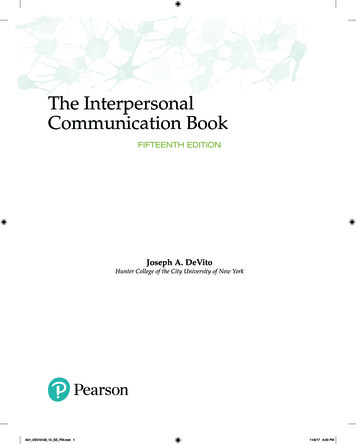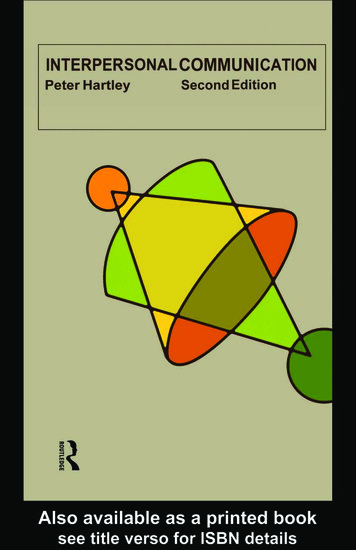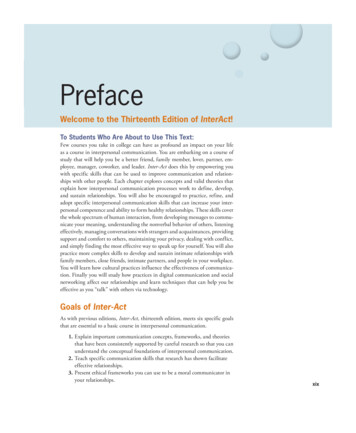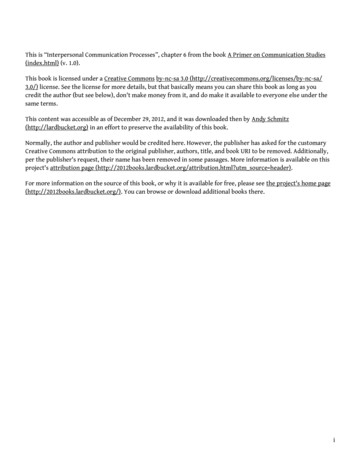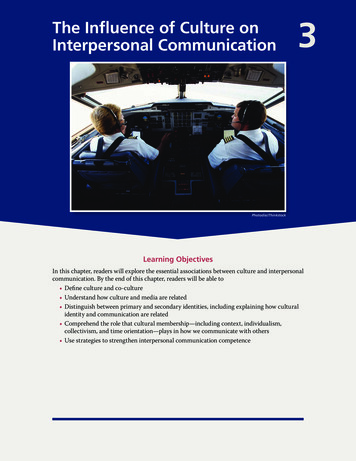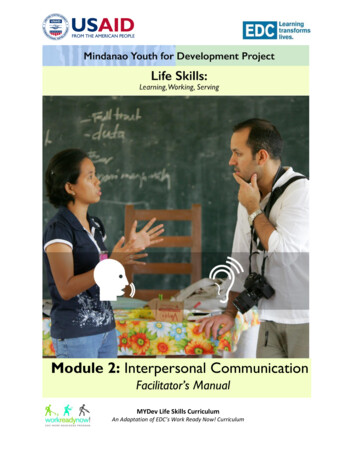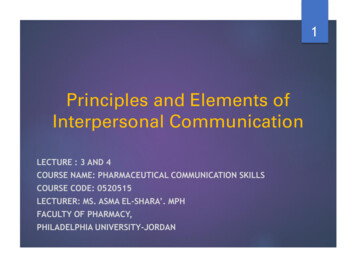
Transcription
1Principles and Elements ofInterpersonal CommunicationLECTURE : 3 AND 4COURSE NAME: PHARMACEUTICAL COMMUNICATION SKILLSCOURSE CODE: 0520515LECTURER: MS. ASMA EL-SHARA’. MPHFACULTY OF PHARMACY,PHILADELPHIA UNIVERSITY-JORDAN
2Contents Setting the Stage Components of the Interpersonal Communication Model Personal Responsibilities in the Communication Model In Search of the Meaning of the Message Importance of Perception in Communication
3Overview Interpersonal communication is a common but complex practicethat is essential in dealing with patients and other health careproviders. This chapter describes the process of interpersonalcommunication as it relates to pharmacy practice and helpsdetermine what happens when one person tries to express anidea or exchange information with another individual. The information given here is the foundation for subsequentchapters that more fully describe strategies for improvinginterpersonal relationships and communication.
4In our personal andprofessional lives, we need tointeract with many people.Settingthe StageSome of these interactionsare successful, while othersare not.Consider case study 2.1.
5CASE STUDY 2.1 George Raymond, a 59-year-old man with moderatehypertension, enters your pharmacy holding an unlit cigar. Youknow George because you attend the same church. He is a highschool principal, has a wife who works, and has four children.He has been told to quit smoking and go on a diet. He also has along history of not taking his medications correctly. He comes topick up a new prescription—an antibiotic for a urinary tractinfection. Although he knows you personally, he is somewhathesitant as he approaches the prescription area. He looks downat the ground and mumbles, “The doctor called in a newprescription for me, and can I also have a refill of my heartmedication?”
6Setting the Stage In most communication encounters, we typicallydo not have the opportunity to stop and analyzethe situation. However, to improve our communication skillswe need some ability to assess a particularsituation quickly.
“7Components of theInterpersonalCommunication Model”
Components of the InterpersonalCommunication Model8 Communication encompasses a broad spectrum of media,for example, mass communication (TV, radio), small-groupcommunication (committee meetings, discussion groups),and large-group communication (lectures, speeches). In Pharmacy setting ONE-TO-ONE interpersonalcommunication that occurs in pharmacy practice.
Components of the Interpersonal CommunicationModel (Continued)9 This specific form of communication (interpersonalcommunication) is best described as a process in whichMESSAGES are generated and transmitted by one person andsubsequently received and translated by another. A practical model of this process is shown in Figure 2.1. Thismodel builds on the original work of Shannon and Weaver(1949) and of George Gerbner (1955). The model includes five important elements: SENDER,MESSAGE, RECEIVER, FEEDBACK, AND BARRIERS.
10FIGURE 2-1. The interpersonal communication model.
111. THE SENDER In the interpersonal communication process, thesender transmits a message to another person.
122- THE MESSAGE In interpersonal communication, the message is theelement that is transmitted from one person to another. Messages can be thoughts, ideas, emotions, information,or other factors and can be transmitted both verbally (bytalking) and nonverbally (by using facial expressions, handgestures, and so on).Research has found that in some situations 55% or moreof a message is transmitted through its nonverbalcomponent.
13THE MESSAGE (continued -3) In most situations, senders formulate or encodemessages before transmitting them. However, in some cases, messages are transmittedspontaneously without the sender thinking about them,such as a glaring stare or a burst of laughter.
143- THE RECEIVER The receiver (you in the above example) receives the messagefrom the sender (Mr. Raymond). As the receiver, you “decode” the message and assign aparticular meaning to it, which may or may not be Mr.Raymond’s intended meaning. In receiving and translating the message, you probablyconsidered both the verbal and nonverbal components of themessage.
154- FEEDBACK FEEDBACK is the process whereby receivers communicateback to senders their understanding of the senders’message. In most situations, receivers do not passively absorbmessages; they respond to them with their own verbal andnonverbal messages. By using verbal and nonverbal communication, the receiverfeeds back information to the sender about how themessage was translated.
16FEEDBACK (continued - 1) In THE FEEDBACK LOOP, the initial receiver becomes thesender of feedback, and the initial sender becomes thereceiver of feedback, as noted in the model. In the interpersonal communication process, individuals arethus constantly moving back and forth between the roles ofsender and receiver. In the example, you were first a receiver of information fromMr. Raymond; when you responded to him with a statement,such as “So you want your medication refilled?” you becamea sender of feedback to Mr. Raymond.
17FEEDBACK (continued - 2) Feedback can be simple, such as merely nodding yourhead, or more complex, such as repeating a set ofcomplicated instructions to make sure that youinterpreted them correctly. Feedback allows communication to be a two-wayinteraction rather than a one-way monologue. During the communication process, most of us tend tofocus on the message and frequently miss theopportunity for feedback.
18FEEDBACK (continued - 3) As receivers of messages, we fail to provide appropriatefeedback to the sender about our understanding of themessage. On the other hand, as senders of messages, we fail to ask forfeedback from the receiver or in some cases ignore feedbackprovided by others. The communication is transactional and the interactionincludes both verbal and nonverbal messages.
195- BARRIERS Interpersonal communication is usually affected bya number of interferences or barriers. These barriers affect the accuracy of thecommunication exchange.
20BARRIERS (continued) - examples For example, if a loud vacuum cleaner was running in your pharmacywhile you ere talking to Mr. Raymond, it would have been even moredifficult to understand what he was trying to communicate. Other barriers to your interaction with Mr. Raymond might include asafety glass partition between you and Mr. Raymond, telephonesringing in the background, or Mr. Raymond’s inability to hear you dueto a defective hearing aid. Barriers can be so detrimental to interpersonal.
21In this counseling situation, what is the pharmacist doingcorrectly?What needs to be improved?
“22Personal Responsibilitiesin the CommunicationModel”
Personal Responsibilities in theCommunication Model 23As a SENDER, you are responsible for ensuring that themessage is transmitted in the clearest form, interminology understood by the other person, and in anenvironment conducive to clear transmission.To check whether the message was received as intended,you need to ask for feedback from the receiver andclarify any misunderstandings.Thus, your obligation as the sender of a message is notcomplete until you have determined that the otherperson has understood the message correctly.
Personal Responsibilities in theCommunication Model (Continued -1)24 As a RECEIVER, you have the responsibility of listening towhat is being transmitted by the sender. To ensure accurate communication, you should providefeedback to the sender by describing what you understoodthe message to be. Many times, we rely on our assumptions that we understandeach other and thus feel that feedback is not necessary. However, practice has found that without appropriatefeedback, misunderstandings occur.
Personal Responsibilities in theCommunication Model (Continued -2)25 Of concern is that, as pharmacists dealing with patients,physicians, and other health care providers, we cannot affordthese misunderstandings. These misunderstandings might result in harm to the patient. To become more effective, efficient, and accurate in ourcommunication, we must strive to include explicit feedbackin our interactions with others. Research has found that when pharmacists communicateeffectively with patients, patient outcomes improve.
“26In Search of theMeaning of theMessage”
27In Search of the Meaning of the Message The interpersonal communication model shows how messagesoriginate from a sender and are received by a receiver. The sender delivers the message, and the receiver assigns ameaning to that message. The critical component in this process is that the receiver’s assignedmeaning must be the same as the meaning intended by the sender. In other words, we may or may not interpret the meaning of thevarious verbal and nonverbal messages in the same way as thesender intended. Thus, the message that the receiver received might not have beenthe one the sender intended to send.
28WORDS AND THEIR CONTEXT1. In general, individuals assign meaning to verbal andnonverbal messages based on their past experiences andprevious definitions of these verbal and nonverbalelements. The most common example of this is evident in differentlanguages and dialects of the world.An example of this misunderstanding occurs in health carewhen we speak in medical terminology that may havedifferent (or possibly no) meaning to our patients.
29WORDS AND THEIR CONTEXT (continued-1)2. Another important factor is that people assign meaningsbased on the context that they perceive the sender isusing. It is the assignment of meaning to those words by thereceiver that is important. Often patients understand the words that we are usingbut place them in a different context. Thus, they may assign a meaning to our message that isdifferent from the one intended.
30WORDS AND THEIR CONTEXT (continued-2)3. The social context also influences how messages are receivedand interpreted. The type of relationship that patients have with their pharmacistsdetermines the level of acceptance that patients have regarding theinformation provided. Research has shown that if patients perceive pharmacists to becredible, unbiased providers of useful information, they will listen andretain more information about their medications. If they perceive pharmacists to be trustworthy and honest, they willbe more willing to approach pharmacists for assistance.
CONGRUENCE BETWEEN VERBAL ANDNONVERBAL MESSAGES31 The meaning of the message may be somewhat unclear if thereceiver senses incongruence between the verbal andnonverbal messages. That is, the meaning of a verbal messageis not consistent with the meaning of a nonverbal message. To avoid this incongruence, AS A SENDER, you must be awareof the nonverbal messages as well as the verbal messages. AS ARECEIVER, you must point out to the sender that you arereceiving two different messages. In reality, the final message is not what is said, but what thereceiver perceives was said.
32Examples of Incongruent Messages A red-faced agitated patron comes into the pharmacy, raises afist, and loudly proclaims, “I’m not angry, I’m just here to askabout a prescription error.” A disappointed pharmacist has tried, so far without success, toconvince a physician to change an obviously inappropriatemedication order. When asked how he is feeling, he meeklyreplies, “Oh, I’m just fine.” A patient hands a pharmacist a prescription for a tranquilizer,then bursts into tears. The pharmacist asks if anything is thematter, and the patient responds, “No, I’m okay, it’s nothing atall.”
33PREVENTING MISUNDERSTANDING A key to preventing misunderstanding is anticipating howother people may translate your message.It may be helpful to determine their experience with drugsin general and with a particular drug specifically. We need to ask certain questions to determine theseperceptions. Have you been on this medication before?What have you heard about this medication? How do youfeel about taking this medication? In many communication interactions, the more you knowabout other people and the more you are able tounderstand them, the easier it will be to anticipate howthey may interpret the meaning of the message.
USING FEEDBACK TO CHECK THEMEANING OF THE MESSAGE34 Predicting how a person will translate a particular message is difficult. Using a technique described earlier (providing feedback to check themeaning of the message) may alleviate some communicationmisunderstandings. As senders of messages, we should ask others to share theirinterpretation of the message. Verifying the fact that the receiver interpreted the intended meaningof our verbal and nonverbal messages accurately takes additional timeand is sometimes awkward. Unfortunately, relying on our intuition is not as effective as obtainingexplicit feedback to measure understanding.
35USING FEEDBACK TO CHECK THE MEANINGOF THE MESSAGE (continued-1) However, the receiver can also alleviate some misunderstandingby offering feedback to the sender. After receiving the message, the receiver should indicate insome way what she understands the message to be. It is particularly important for pharmacists to provide feedbackby summarizing the information they have received frompatients in the course of interviews conducted or assessmentsmade related to their drug therapy.
36USING FEEDBACK TO CHECK THE MEANINGOF THE MESSAGE (continued-2) Since the pharmacist is primarily the “receiver” when he isobtaining information from patients on their symptoms orcurrent therapy, the pharmacist should provide feedback toverify his understanding. When the pharmacist is primarily the “sender,” as when heis giving information on a new prescription, then the patientshould be asked to summarize key information presented asa way of providing feedback that the pharmacist’s messagewas understood accurately.
37“Importance of Perceptionin Communication”
38Importance of Perception in Communication Perception is important in the process of interpersonalcommunication because we tend to interpret messagesbased on our perception of1) what we believe the message says and2) the individual sending the message.Thus, perceptual barriers need to be identified andminimized or we will misinterpret what we hear.We need to recognize how fragile the communicationprocess is during professional communication and to valuethe use of feedback to enhance our ability to verify thetrue meaning of messages.
1. PERCEPTION OF MEANINGS WITHIN AMESSAGE39 People assign meanings to verbal and nonverbal messagesbased on their perception of the intended meaning. In other words, the receiver’s perception of the words,symbols, and nonverbal elements used by the senderinfluences how the receiver interprets the meaning. It is not what is said, but what the receiver perceives tohave been said.
40PERCEPTION OF MEANINGS WITHIN A MESSAGE(continued-1) Misperceptions occur frequently in pharmacy practice,and most pharmacists have a story to tell about howpatients misuse medication based on theirmisperceptions. In general, people develop their perceptions based ontheir past experiences, background, and values. It is difficult to realize when your patients have differentperceptions than you.
PERCEPTION OF MEANINGS WITHIN A MESSAGE(continued-2) 41One skill that minimizes perceptual differences is to USEterms and concepts that are familiar to the patient. Youshould also avoid using professional jargon.
2. PERCEPTIONS OF INDIVIDUALS Pharmacists’ perceptions42 Our perception of the message is also influenced by ourperception of the individual sending the message. How we perceive the sender affects the interpretation ofthe message. We respond using our perception of that individual as ourreference point because we tend to be influenced by aperson’s cultural background, status, gender, or age. These perceptions are further influenced by any bias wehave or stereotypes we hold of certain groups ofindividuals.
The following statements illustratethis point:43 “People who are mentally ill do not comply with theirmedication regimens.” “Nurses always complain about pharmacists.” “Elderly people can’t hear well and always talk too much.” “People who talk slow are lazy.” “Women with red hair have a temper.” “People who are overweight are jolly.”
PERCEPTIONS OF INDIVIDUALS(continued-1)44 We do not see the person as a unique individual but as arepresentative of a particular group (e.g., elderly, overweight,or mentally ill). We erect “perceptual barriers” to the communication processnot based on fact but on our inferences based on stereotypes. Unfortunately, these barriers inhibit true communicationbetween individuals.
PERCEPTIONS OF INDIVIDUALS(continued-2)45 It is important to realize that during our interactions withothers we create perceptions of individuals and makevarious assumptions. For example, we tend to believe that our patients can speak andunderstand English well enough to understand us unless they tell usotherwise. Unfortunately, this is not always the case because many patients, in aneffort to avoid embarrassment, do not indicate that they do notunderstand our instructions.
PERCEPTIONS OF INDIVIDUALS(continued-3) We need to evaluate when our perception of thesender is incorrect or when our assumptions mightbe interfering with our ability to communicate withothers. We may need to “check” our assumptionsbefore proceeding. Increased awareness of stereotyping and additionaleffort in checking our assumptions can enhance ourinterpersonal communication.46
PERCEPTIONS OF INDIVIDUALS(continued-4) People’s perception47 Unfortunately, the people we deal with on a daily basis may haveperceptions of pharmacists that interfere with our ability tocommunicate with them. Their perceptions may not be based on reality but on theirstereotypes of pharmacists. For example, patients may perceive us as uncaring, busy peoplewho are concerned only with filling prescriptions and taking theirmoney. These stereotypes influence what they say to us and how theylisten to us. If they perceive us as professionals, they will listen to what we tellthem about their medications.
PERCEPTIONS OF INDIVIDUALS (continued5) Other professionals’ perception48 By the same token, if nurses, physicians, and other healthcare providers do not perceive us as professionals, they willnot value the information we provide. Part of improving communication with others is todetermine what their perceptions of pharmacists are andthen try to alter those perceptions if they are unfounded.
493. SHARING THE SAME PERCEPTIONS One key to preventing misunderstanding is to try tounderstand and share the perceptions of other individuals. Many times, using “lay language,” which is familiar topatients, rather than medical terminology, which is familiaronly to health care professionals, can enhance understanding.
SHARING THE SAME PERCEPTIONS(continued-1)50 Determining the patient’s past experience with medicationsor with the particular drugs prescribed may also be helpful. Patients who have had positive experiences previously maybe more willing to take the medication. However, if their past experiences have been bad, they maybe reluctant to even begin taking the medication.
SHARING THE SAME PERCEPTIONS(continued-2)51 Frequently, it is difficult to understand patient backgroundsand to predict perceptions of the messages we provide. Follow the suggestions found in the “Advice PharmacistsShould Follow When Communicating with People ofDifferent Backgrounds” box. In many communication interactions, the more we canknow about the other person and the more they can knowabout us, the easier it is to share the same perception.
Advice Pharmacists Should Follow When52Communicating with People of DifferentBackgroundsLearn as much as you can about the patient’s background. Mostcommunication problems arise when there is a lack of knowledgeabout the other person’s reasons for a particular communicationstyle. View diversity as an opportunity. With a little patience and theright attitude, you will be amazed at the opportunities that crop upto help one another. Do not condescend. Patronizing behavior is not appreciated and isrecognized as such in any culture. Talk about your differences. Misunderstandings will often take rootwhen people from differing backgrounds do not talk to oneanother. Be willing to talk openly and with a constructive attitude.
53USING FEEDBACK TO VERIFY PERCEPTIONS The best technique to alleviate harmfulmisperceptions is using feedback to verify theperceived meaning of a message. As senders of messages, we should ask others to sharetheir interpretations of the message. We typically do not ask for feedback from patients tocheck their perceptions of the words used when wegive directions.
USING FEEDBACK TO VERIFY PERCEPTIONS(Continued)54 We simply assume that patients understand us. Just think how many medication misadventures could beprevented if pharmacists asked patients to give themfeedback using this phrase, “Before you leave could youplease tell me how you are going to use this medicine?” The receiver can also alleviate some misunderstanding byoffering feedback to the sender. After receiving the message, receivers should summarizethe key elements of the message.
“55SUMMARY”
56Summary - 1 The interpersonal communication model reveals that youmust recognize that interpersonal communication is morethan merely speaking to others, offering a printedprescription label, or affixing an auxiliary label to aprescription. You must make sure that the messages you transmit toothers are received accurately.There is no guarantee that the meaning of your messagewill be translated as intended.You need to make sure that you enhance your listeningskills so that you can become a better receiver ofmessages as well.
57Summary - 2 In the remaining chapters, we provide practical skills necessary for improving yourcommunication. Each chapter builds on the preceding one. Communication is a complex process that may be difficult forsome. However, it is a process that can be easily managed andcontrolled like any other learned skill. By emphasizing practical applications, we hope to lower anybarriers that you may have to improvement of the valuableskills involved in communicating effectively. Before going further, go back and reread your comments about case study 2.1(Mr. Raymond’s situation) and change anything that you would do differently.
58THANK YOU
Components of the Interpersonal Communication Model (Continued) This specific form of communication (interpersonal communication) is best described as a process in which MESSAGES are generated and transmitted by one person and subsequently received and translated by another. A practical
